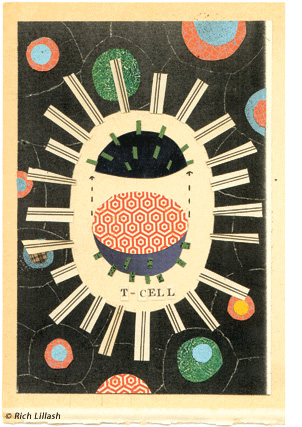Reprogrammed Immune Cells Vanquish Cancer in Promising Breakthrough

Part of the reason Michael Kalos came to Penn three years ago was to be part of a strong team of doctors who could come together for the common good. He just never fully expected how much good they would be able to achieve.
In a breakthrough that has garnered worldwide attention, Penn announced in August that a team of researchers from the Abramson Cancer Center and Perelman School of Medicine—Carl June, a professor of pathology and laboratory medicine; David Porter, a professor of medicine and director of blood and marrow transplantation at the Hospital of the University of Pennsylvania; Bruce Levine C’84, a research associate professor of pathology and laboratory medicine; and Kalos, an adjunct associate professor of pathology and laboratory medicine—have discovered a way to train a person’s own immune system to kill cancer cells. The discovery was made after three patients diagnosed with advanced chronic lymphocytic leukemia—a slow-progressing cancer of the blood and bone marrow—had their T-cells removed, altered with new genes, and then reinserted back into the body to fight the leukemia.
Even the doctors admitted the results were beyond their wildest hopes. Two of the patients have been in complete remission for one year, and the third had a partial remission. (The third patient’s progress may have been arrested by steroid treatment administered at another hospital, which the other patients did not undergo.)
“All of our careers have really evolved around the concept of T-cell therapy-based treatment of cancer and infectious disease,” Kalos says. “So for us to get to the point where we actually conducted a trial with such dramatic results in patients … this was very emotional for all of us.”
Kalos, who directs the Translational and Correlative Studies Laboratory at Penn’s Stellar-Chance Laboratories, believes the results were so positive, in part, because Penn Medicine’s infrastructure is unique, with each doctor contributing a specific area of expertise.
June, who is the director of translational research in the Abramson Cancer Center, oversaw the trial and has been working on the idea for approximately 20 years, dating back to his service as a bone marrow transplant doctor in the US Navy. Levine, who directs the clinical vaccine production facility, manufactured the T-cells in a way that they could be infused back into the patients. Porter is the physician who actually treated the patients involved in the trial. And Kalos evaluated the clinical trial in the lab to determine if the treatment worked and if any modifications were needed.
“This is the way you get things to work,” says Kalos. “All of the expertise doesn’t lie in one person.”
While this kind of gene-transfer therapy has been around since the 1980s, the ability to “genetically engineer T-cells effectively,” according to Kalos, is only about five to seven years old, and even in that time frame there have been “multiple evolutions” in the field.
He believes one of the big differences in this particular case was that the patients’ T-cells were reprogrammed using a lentivirus vector (derived from a disabled form of the HIV virus), which the Penn team pioneered. That allowed the infused T-cells to turn into what June called “serial killers,” with each one destroying thousands of tumor cells. And while these therapies are very potent and only appropriate for patients with no other options, Kalos is quick to point out that the lentivirus has no potential to infect people.
“Every one of our observations have been home runs, and given us some hope that we have an approach that will really put a dent into cancers,” says Kalos, who was the lead author of the Science Translational Medicine paper on the findings. (The work was also reported in the New England Journal of Medicine, with Porter as the lead author. Three other researchers, all affiliated with Penn, also contributed to the research: Adam Bagg, Sharyn Katz Gr’09, and Stephan Grupp.)
Of course, the researchers know there is still a long way to go with this kind of treatment, and will not use the word “cure” when talking about their patients because, Kalos says, “that gives people hope that may not be fulfilled.”
“We’ve treated three people and we have to treat many more,” he explains. “We have a lot of work ahead of us. And although this was exciting and fun, the ultimate objective is to develop these therapies in a way that will actually cure people and help people. We’re not there yet. It’s humbling to be talking about all this publicity when we’re still at the beginning of seeing if this works.”
The next step is to treat other kinds of cancers, such as non-Hodgkin’s lymphoma and acute lymphocytic leukemia, while securing more funding and trying to get pharmaceutical companies on board. Already, Kalos notes, foundations and philanthropists have come out of the woodwork to offer money.
The publicity their work has received has been extensive—ranging from a lengthy New York Times feature to an article in a Chinese newspaper that Kalos amusedly keeps in his office, with his and June’s names in Chinese highlighted—but for the Penn doctors, the best part was the therapy’s impact on their patient’s health. When Kalos first called June to relay some of the initial test results, he heard his colleague’s voice break. And then he heard June say, “This is the most amazing data I’ve ever seen in my entire career.”
“Your job description means you’re going to be failing most of the time,” Kalos says. “We rarely see something so dramatic. So to see this dramatic result, it was incredibly energizing. The sense of excitement was certainly palpable.”
—Dave Zeitlin C’03




